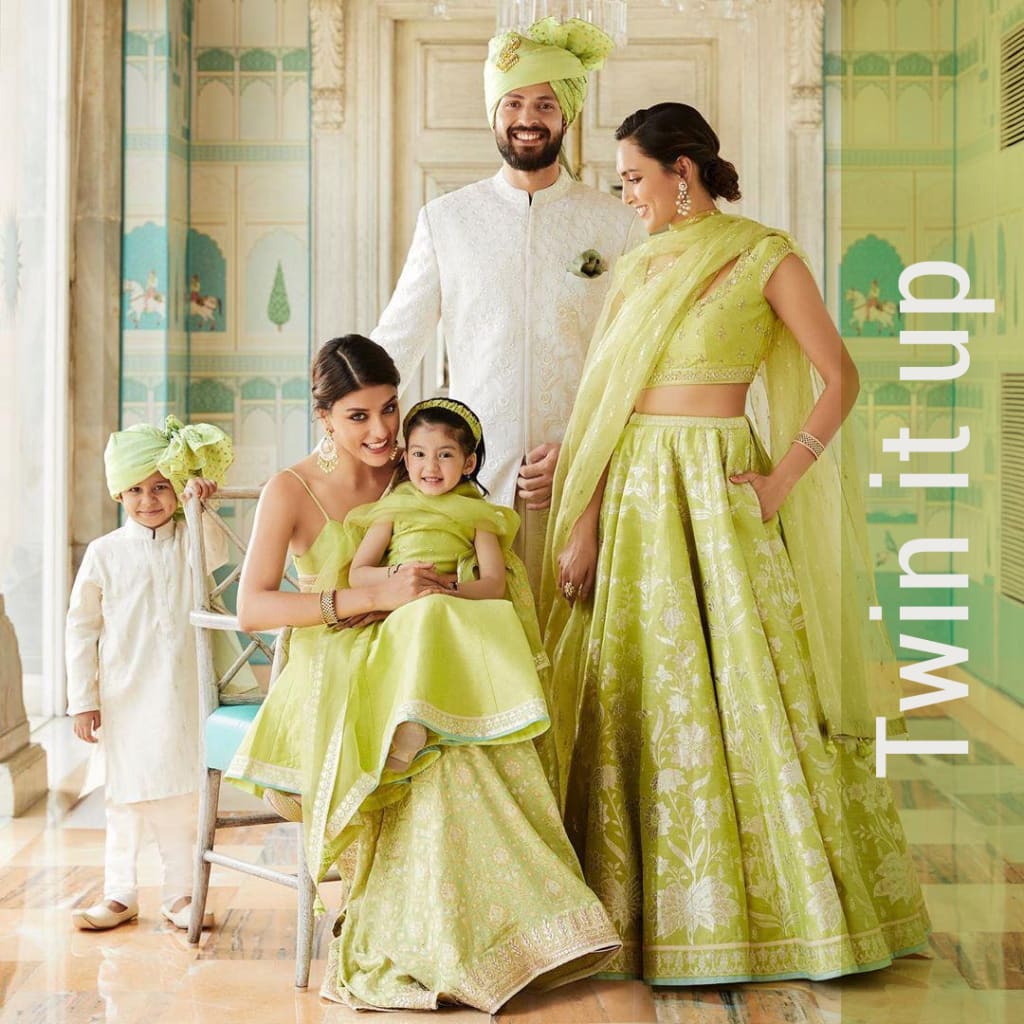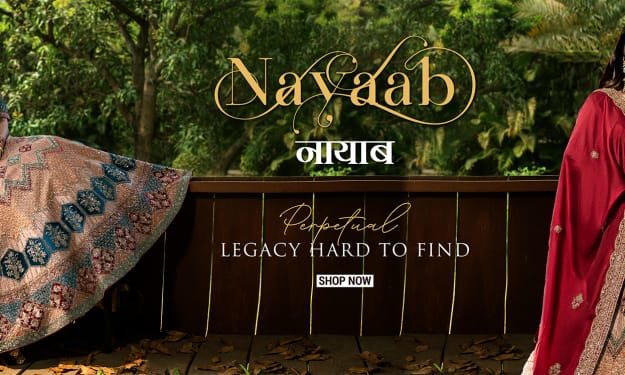The Cultural Significance of Indian Wear: Exploring Traditional Attire for All Ages
Indian attire has a rich history and is deeply rooted in the country's diverse cultural heritage. It has evolved over time and continues to be a source of inspiration for designers around the world.

Indian fashion has a rich and diverse history that has evolved over centuries. The traditional Indian wear is a beautiful expression of the country's unique culture, style, and heritage. From the vibrant colors to the intricate embroidery, the traditional Indian attire is an art form that has stood the test of time. Each region of India has its own distinctive style and unique fabrics that reflect the history and culture of the area. The Indian traditional attire is not only beautiful but also versatile, with styles that are suitable for every occasion, from weddings to casual outings. In this post, we will explore the elegant beauty of traditional Indian attire and why it remains a timeless fashion statement.
1. Introduction to Traditional Indian Attire
India is a land of diverse cultures, traditions, and beliefs. One of the most striking aspects of India's diverse culture is the vibrant and varied traditional attire worn by its people. Indian traditional attire is known for its rich colors, intricate designs, and timeless elegance that never goes out of style.
Traditional Indian attire has a long and fascinating history that dates back to ancient times. The different types of attire worn across India today are a reflection of the country's diverse history, geography, and culture. From the colorful sarees of South India to the ornate lehengas of North India, each traditional attire has its unique charm and is a symbol of pride for the people who wear them.
Indian wear has not only captured the imagination of people in India but has also gained popularity around the world. Many fashion designers have drawn inspiration from the traditional attire of India and incorporated it into their designs, giving it a modern twist while still preserving its traditional elegance.
In this post, we will take a closer look at the different types of traditional attire worn across India, their cultural significance, and the timeless elegance that makes them so special. Whether you are a fashion enthusiast or just someone who appreciates the beauty and diversity of different cultures, we invite you to join us on this journey into the world of traditional Indian attire.
2. The significance of Indian attire
Indian attire is more than just clothing. It is a reflection of the country's rich and diverse cultural heritage, traditions, and religious beliefs. Each type of Indian wear has a unique significance and symbolism attached to it, making it an essential part of the Indian culture.
For instance, the saree is a traditional Indian attire worn by women across the country. It is not just a piece of cloth wrapped around the body, but it represents the grace, elegance, and beauty of a woman. The saree has been a part of Indian culture for centuries and has evolved with time, but its significance remains the same.
Similarly, the kurta-pajama is a traditional Indian outfit worn by men. It reflects the simplicity and comfort that is deeply rooted in Indian culture. The intricate embroidery and embellishments on the kurta represent the fine craftsmanship of Indian artisans.
Indian attire is not just limited to the saree and kurta-pajama. There are many other types of traditional Indian outfits such as lehenga-choli, salwar-kameez, dhoti-kurta, and more, each having its own unique significance and symbolism.
Wearing traditional Indian attire not only reflects the cultural identity but also promotes heritage and pride. It is a way of preserving and promoting the country's rich cultural heritage and legacy, making it a timeless and cherished part of the Indian lifestyle.
3. Types of Traditional Indian wear for women
Traditional Indian attire for women is a beautiful and unique combination of style, elegance, and culture. India is a land of diverse cultures, and therefore, traditional attire for women varies from region to region. Here are some of the most popular types of traditional Indian attire for women:
1. Saree: A saree is a long piece of cloth draped around the body in a specific manner. It is worn with a blouse and can be made of different fabrics such as cotton, silk, or chiffon. Sarees come in a variety of designs and patterns and are a symbol of Indian femininity.
2. Salwar Kameez: The Salwar Kameez is a comfortable and versatile outfit that consists of a long tunic (kameez) worn over loose-fitting pants (salwar). It is typically made of cotton and is perfect for everyday wear.
3. Lehenga Choli: The Lehenga Choli is a popular outfit worn during weddings and other formal occasions. It constitutes a long skirt (like a lehenga) along with a short blouse (called choli) and a dupatta (scarf). It is often made of silk, with intricate embroidery and embellishments.
4. Anarkali Suit: The Anarkali Suit is a beautiful and elegant outfit that consists of a long, flowing kurta (tunic) paired with fitted pants (churidar). It is usually made of silk or georgette and is great for events such as weddings and parties.
5. Dupatta: A Dupatta is a long scarf that is worn with a variety of traditional Indian outfits such as the salwar kameez, lehenga choli, and saree. It is often made of silk or chiffon and is used to add an extra element of style and elegance to the overall look.
These are just a few examples of the many types of traditional Indian wear for women. Each outfit is unique and represents a specific region or culture of India. Traditional Indian attire has stood the test of time, and its elegance and beauty continue to captivate people around the world.
4. Types of Traditional Indian Attire for men
Traditional Indian attire is not just limited to women; it is equally popular among men as well. Indian men's clothing is known for its intricate designs, vibrant colors, and comfortable fabrics. The most popular traditional Indian attire for men is the Kurta-pajama. It is a long tunic-like shirt that falls below the knee and is paired with loose-fitted pants. Kurta-pajama is worn on various occasions such as weddings, festivals, and formal events.
Another popular traditional Indian attire for men is the Sherwani. The Sherwani is a long coat-like garment that is worn over the Kurta-pajama. It is usually made of silk or other luxurious fabrics and is adorned with elaborate embroidery and embellishments. Sherwanis are typically worn by grooms on their wedding day or by men attending formal events.
Dhoti is another traditional wear for men worn on special occasions. It is a rectangular piece of fabric that is draped around the waist and legs. Dhotis are usually made of cotton or silk and they come in variety of designs and colors..
Bandhgala is a traditional Indian suit that is popular among men for its formal and elegant look. It is a jacket that is worn with matching trousers. Bandhgalas are usually made of silk or wool, and are often embellished with embroidery.
In conclusion, traditional Indian attire for men is as diverse and vibrant as that for women. From the colorful Kurta-pajama to the luxurious Sherwani and the elegant Bandhgala, men's traditional Indian attire is a perfect blend of culture and style.
5. Regional variations in Traditional Indian Attire
One of the most fascinating things about traditional Indian wear is the incredible regional variation that exists within this clothing style. India is an enormous country, with a wide variety of different cultures, languages, and traditions. As a result, traditional Indian attire varies widely from region to region, each with its own unique style, fabrics, and techniques.
For example, in the northern region of Punjab, traditional attire for women includes the salwar kameez, a flowing tunic-style top paired with loose pants and a scarf. In contrast, in the western state of Gujarat, women traditionally wear the colorful and ornate lehenga choli, a long skirt paired with a short blouse and a dupatta scarf.
Meanwhile, in the southern state of Tamil Nadu, women often wear the stunning Kanjeevaram saree, a silk saree with intricate gold-threaded designs. In the eastern state of West Bengal, on the other hand, the traditional attire for women is the graceful and elegant saree, often made of soft cotton or silk.
These are just a few examples of the incredible diversity of traditional Indian attire, and there are countless other regional styles and variations to be discovered. This diversity is a testament to the richness and complexity of Indian culture and the enduring appeal of traditional Indian clothing.
6. Incorporating Traditional Indian Attire into contemporary fashion
Incorporating traditional Indian attire into contemporary fashion is a trend that has been gaining popularity in recent years. Designers are taking inspiration from traditional Indian garments and incorporating them into their contemporary designs to create a fusion of cultures and styles.
One popular example of this is the fusion of the traditional Indian saree with a western-style blouse. Designers are experimenting with different fabrics, prints, and styles to create a contemporary look while still keeping the essence of the traditional saree intact. Another popular example is the fusion of Indian kurtis with jeans or leggings to create a trendy and comfortable outfit.
The beauty of incorporating traditional Indian wear into contemporary fashion lies in the fact that it allows individuals to express their cultural identity while still being fashionable. It also allows for the preservation and promotion of traditional Indian art forms and craftsmanship.
Whether it's a fusion outfit or a complete traditional Indian attire, the timeless elegance of Indian culture and style has always been a fashion statement. Incorporating traditional Indian attire into contemporary fashion is not just a trend, it's a celebration of the rich and vibrant culture of India.
7. How to accessorize Traditional Indian Attire
Accessorizing traditional Indian attire is an art in itself. The right accessories can elevate a simple outfit to a stunning one. Here are some tips on how to accessorize traditional Indian attire:
1. Jewelry: Traditional Indian jewelry is known for its intricate designs and vibrant colors. A statement necklace or a pair of chandelier earrings can add a touch of elegance to your outfit. If you are wearing a heavy outfit, go for minimal jewelry, and if you are wearing a simple outfit, then go for statement jewelry.
2. Footwear: Indian footwear is not just comfortable but also stylish. Juttis, Kolhapuris, and Mojaris are some of the popular footwear options. If you are wearing a heavily embroidered outfit, then go for simple footwear, and if you are wearing a simple outfit, then go for footwear that has intricate designs and embellishments.
3. Handbags: A traditional Indian wear is incomplete without a matching handbag. A potli bag or a clutch with intricate embroidery and embellishments can complete your look.
4. Hair accessories: Maang tikkas, hairpins, and hairbands are some of the popular hair accessories that can add a touch of glamour to your outfit. If you are wearing a heavy outfit, then go for simple hair accessories, and if you are wearing a simple outfit, then go for hair accessories with intricate designs.
Remember, when it comes to accessorizing traditional Indian attire, less is more. Do not go overboard with accessories, and always choose accessories that complement your outfit.
8. The evolution of Indian Attire over time
Indian wear has been a symbol of elegance and cultural heritage for centuries. The traditional attire of India over time has gone through numerous transformations, each reflecting the spirit of the era and the region. From the draping sarees to the regal sherwanis, Indian attire has a rich history and cultural significance.
In the ancient era, the traditional attire of India was simple and primarily made of cotton or silk. Women wore sarees and men wore dhotis and kurtas. The sarees were draped in different styles across different regions, reflecting the cultural diversity of India.
During the Mughal Empire, the attire of India saw a significant shift. The royal Mughals introduced the regal and grandeur fashion of Anarkalis, lehengas, and sherwanis. The intricate embroidery, embellishments, and use of luxurious fabrics like silk and velvet made the attire grand and opulent.
In the colonial era, the Indian attire saw a blend of western and Indian styles. The British introduced the concept of tailored suits and jackets for men, while women started wearing western dresses. However, the traditional attire of India remained unaffected and continued to thrive.
In the contemporary era, Indian Attire has seen a revival, with a fusion of traditional and modern styles. The introduction of new fabrics like georgette, chiffon, and net has given Indian attire a new dimension. The lehengas, sarees, and kurtas have evolved with new designs, patterns, and colors, while still retaining the cultural essence.
In conclusion, the evolution of Indian attire over time reflects the rich and diverse cultural heritage of India. The traditional attire has managed to sustain its elegance and cultural significance, while also evolving with the changing times. The timeless appeal of Indian attire is here to stay, as it continues to inspire and captivate fashion enthusiasts across the globe.
9. The role of Indian Attire in cultural celebrations and festivals
Indian attire has always been an integral part of the country's rich cultural heritage and history. It is not just about fashion but also a reflection of the country's diverse regional cultures and traditions. Indian festivals and cultural celebrations are incomplete without the traditional attire that adds to the joyous and celebratory atmosphere.
During festivals and cultural events, people in India adorn themselves with colorful and vibrant traditional attire that varies from region to region. For instance, during Diwali, a festival of lights, women in North India wear colorful sarees or salwar kameez, while in the Southern part of India, women wear silk sarees or pavada davani. Similarly, during Holi, the festival of colors, people wear bright and colorful clothes to celebrate the festival's spirit of joy and togetherness.
Traditional Indian attire is not just limited to festivals but is also an essential part of weddings and other social events. From the intricate embroidery work to the use of rich fabrics like silk, cotton, and chiffon, Indian attire exudes elegance and sophistication. The vibrant colors and intricate designs are a testament to the country's rich cultural heritage and history.
In conclusion, Indian attire plays a vital role in cultural celebrations and festivals, adding to the festive spirit and joyous atmosphere. It is not just about fashion but also a reflection of the country's diverse regional cultures and traditions, making it truly timeless and elegant.
10. Conclusion: Embracing the Timeless Elegance of Traditional Indian Attire.
In conclusion, traditional Indian attire has been an integral part of India's rich cultural heritage for centuries. From the vibrant sarees to the intricate embroidery of salwar kameez, each piece reflects the timeless elegance of Indian culture and style.
The popularity of traditional Indian attire has transcended borders and has become a global trend. With the rise of sustainable and ethical fashion, it is now more important than ever to embrace the beauty of traditional Indian attire and its eco-friendly practices.
Not only does traditional Indian attire showcase the intricate craftsmanship of Indian artisans, but it also pays homage to the rich history and traditions of the country. It is a celebration of India's diverse culture, and wearing it is a way of honoring this beautiful heritage.
As we move towards a more inclusive and diverse society, it is important to embrace the beauty of traditional Indian attire and all the cultural significance it holds. Whether you are attending a wedding, a cultural event, or just want to add some color and elegance to your wardrobe, traditional Indian attire is a timeless and stylish choice that will never go out of fashion.
We hope you enjoyed our article on traditional Indian attire and the timeless elegance of culture and style that it represents. Indian attire has a rich history and is deeply rooted in the country's diverse cultural heritage. It has evolved over time and continues to be a source of inspiration for designers around the world. Whether you're looking to incorporate traditional Indian attire into your wardrobe or simply appreciate the beauty of Indian fashion, we hope that this article has provided you with valuable insights. Remember to embrace your style and heritage in whatever way you choose, and always wear it with pride.





Comments
There are no comments for this story
Be the first to respond and start the conversation.